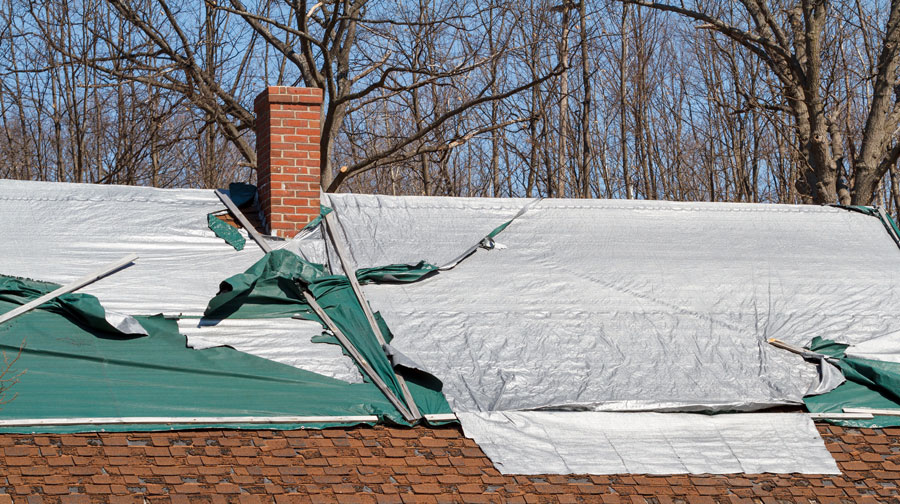How Do I Tarp a Roof?
Your Comprehensive Guide To Tarping a Roof
Do you have water coming into your home or building? Experiencing a leaky roof can be one of the most daunting challenges we face as a homeowner or business owner. These types of problems are serious, as they can escalate quickly. Roof leaks and roof damage can cause significant damage to the interior of your home if not promptly addressed. Here in the Greater Dayton area – where weather conditions can be unpredictable — understanding how to assess the damage and tarp a leaking roof is an essential skill. We aim to provide you with the knowledge to cover the damaged area and secure a tarp with proper safety in mind.
Conditions for Tarping a Roof
Before you begin to climb up onto your roof, it’s first essential to assess whether tarping is the appropriate route to take. Metal roofing and other types of roofing material (like slate and others) can present unique challenges when they get damaged. Keep in mind that tarping serves only as a temporary fix. This temporary bandage prevents water damage from escalating until we can come out and provide a permanent repair.
A few of the optimal conditions for tarping include the following:
- Insurance Reasons: Some insurance companies require proof that measures like tarping were taken to mitigate further damage while waiting for a roof repair. They want to see you’re not allowing the damage to become worse.
- Optimize Money Savings: Properly executed, tarping can save money on roof repair costs by preventing water from entering and escalating and causing more significant problems, as we noted above.
- Temporary Protection from Bad Weather: If a storm has temporarily subsided and another is expected soon, tarping can safeguard your home or business from further damage.
Regardless of the conditions, it’s always important to ensure safety by checking for structural stability and using all the appropriate safety gear and safety equipment. If you aren’t sure whether the damage is extensive, give us a call! Utilizing a trusted local professional like Van Martin Roofing is always a good idea! We have all your roofing needs covered under one roof – no pun intended! We offer fast and affordable roof tarping services throughout the Miami Valley Ohio area.
Best Tarps for Leaking Roofs
Selecting the right tarp is the next essential step in the process of effectively protecting everything. According to Tarps Now, heavy-duty polyethylene tarps are among the best tarps available on today’s market for this purpose. This type of tarp (heavy-duty polyethylene) is durable, waterproof, and resistant to ultraviolet light from the sun. This makes them an excellent choice for emergency roof protection. When choosing a tarp, additionally, you should consider the following:
- Choose a tarp with grommets to facilitate easier usage and secure attachment with ropes or bungee cords.
- Ensure the tarp is more than large enough to cover the entire damaged area plus an additional area around the damage for proper anchoring.
Step by Step Guide to Tarp a Roof
Tarping a roof isn’t a job for every homeowner, as it requires patience and attention to detail. You’ll need some basic skills, and you will also need to be comfortable and safe on heights. The following is a quick list on how to do so:
- How to Tarp a Roof: Using a safe and sturdy ladder, make sure you wear non-slip shoes. Also, if possible, work with a friend or family member for added safety on site.
- Inspect the Roof: Find and identify damaged areas and clear away any debris or sharp objects that could puncture the tarp or prevent proper tarping.
- Measure the Area: Make sure the tarp covers the entire damaged section – with ample amounts of extra space around the edges for proper anchoring security. Use a tape measure.
- Properly Position the Tarp: Usually, you’ll want to start at the roof’s peak. From there, roll out the edges of the tarp over the damaged area, enabling it to extend over the roof’s ridge.
- Properly Secure All the Edges: You’ll want to use wooden anchor board to sandwich the tarp’s edges. Use these custom boards to nail the tarp to the roof. Using this method is ideal because it minimizes wind lift and prevents additional damage.
- Make Sure to Attach Firmly: Next, tie down the tarp using ropes through the grommets to the roof structure. You can also consider using heavy-duty bungee cords for added security. Just make sure the wind doesn’t move the tarp or tear it off as we know how Ohio’s weather can be!
In short, taking these essential steps to the best of our ability can provide a temporary fix that’s reliable until a professional like Van Martin comes to help. This also prevents water damage until professional help gives you more of a long-term solution.
Remember, the best solution is to tarp your roof as soon as there’s potential for storms or inclement damage. However, if damage has already occurred and you need to protect the area, tarping is a great temporary solution.
How long can a roofing tarp last?
Our experts say you should never go longer than 1-3 months for a roof tarp, and this is only when it has been done properly.
Are you looking for additional help? If so, call Van Martin today!
Although tarping a roof is within the skill set of a lot of people here in the Greater Dayton area, it’s still only a temporary solution at best. If not done properly, it can lead to additional harm.
The importance of contacting a professional roofing contractor like Van Martin Roofing for a permanent repair cannot be overstated. With 20 years of expertise in handling all types of roofing repairs and replacements, our team of friendly local professionals can ensure your home remains safe and secure for years to come. And emergency roof tarping services are one of our specialties!
For emergencies or regular maintenance, don’t hesitate to call us at (937) 222-7855.



